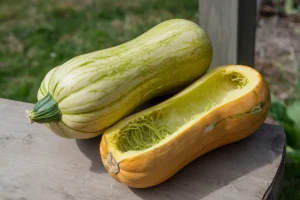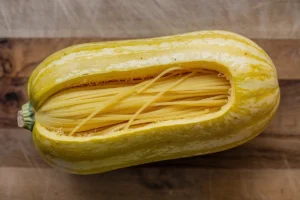Growing your own food is one of the most rewarding experiences for home gardeners. Among the favorite plants is the spaghetti squash, which offers a delightful and nutritious alternative to pasta. However, gardeners often encounter a common issue: their spaghetti squash remains green instead of turning the expected bright yellow. So, why is spaghetti squash green, and what can be done about it?
In this comprehensive guide, we’ll cover the reasons your spaghetti squash might be staying green, what it means for ripeness, and how you can address it. We’ll also provide tips for growing and harvesting, exploring potential cross-pollination issues, and answer frequently asked questions. Let’s dig deep into the world of green spaghetti squash and get to the root of the issue!
What is Spaghetti Squash?
Before we dive into the mystery of green spaghetti squash, let’s take a closer look at what this plant is. Spaghetti squash is a type of winter squash, known for its distinctive stringy flesh that resembles spaghetti when cooked. It’s a popular low-carb substitute for pasta, rich in vitamins A, C, and fiber. A fully ripened spaghetti squash is typically yellow or golden in color, signaling that it is ready to harvest.
However, many gardeners are surprised when their squash remains green. This unusual color can lead to confusion and raises questions about the ripeness, safety, and quality of the squash. But don’t worry – there are several reasons why your squash may still be green, and most of them are completely natural.
Why is My Spaghetti Squash Green?
When you see a green spaghetti squash growing in your garden, your first thought might be that something went wrong. But in many cases, a green squash is simply immature and needs more time to ripen. Just like tomatoes or other fruits, spaghetti squash goes through a color change as it matures.
Here are some key reasons your spaghetti squash may be green:
1. Immature Squash
The most common reason your spaghetti squash is still green is that it hasn’t had enough time to ripen. Spaghetti squash typically takes between 90 and 120 days from planting to full maturity. If harvested too early, the squash will be green or have a greenish tint. Immature spaghetti squash may not have developed its full flavor and texture, which is why it’s important to give it enough time on the vine.
2. Sunlight Exposure
Sunlight plays a critical role in the ripening process. Spaghetti squash plants need full sunlight to grow and ripen properly. If your squash is growing in a shaded area, it may not receive enough light to turn yellow. The result? A green squash that remains on the vine longer than expected.
If you suspect that a lack of sunlight is the problem, consider moving your plants to a sunnier spot or trimming back nearby foliage that may be casting shade on your squash.
3. Temperature
Temperature is another factor that affects the ripening process of spaghetti squash. Cool temperatures can slow down the development of squash, leaving it green for an extended period. Spaghetti squash thrives in warm weather, and it needs consistent temperatures of around 70-85°F (21-29°C) to ripen fully. If your area experiences cooler temperatures during the growing season, your squash may not ripen as quickly as expected.
4. Cross-Pollination
Cross-pollination occurs when pollen from one plant fertilizes another plant of a different variety. This is common in plants from the Cucurbitaceae family, which includes squash, zucchini, cucumbers, and pumpkins. If your spaghetti squash has cross-pollinated with a different type of squash or zucchini, it may develop an unusual color, such as green.
While cross-pollination doesn’t affect the safety or edibility of the squash, it can lead to variations in color, texture, and flavor. If you have other squash varieties growing nearby, cross-pollination could be the reason your spaghetti squash is green.
What Does It Mean If My Spaghetti Squash Is Green?
Now that we’ve identified some of the reasons why your spaghetti squash might be green, let’s discuss what this actually means for the squash itself. Is it safe to eat? Will it ripen off the vine? Let’s answer these questions.
1. Ripeness
A green spaghetti squash is likely not fully ripe. When fully mature, spaghetti squash turns a golden yellow or deep orange, depending on the variety. Green indicates immaturity, and the squash may not have reached its full potential in terms of flavor or texture.
That being said, green spaghetti squash can still ripen if left on the vine for a bit longer. With enough time, proper sunlight, and warm temperatures, the squash will usually turn yellow as it matures. However, if the squash is picked too early, it may never fully ripen off the vine.
2. Edibility
Is it safe to eat green spaghetti squash? Yes, green spaghetti squash is safe to eat, but it may not taste as good as fully ripe squash. Immature spaghetti squash can be bland, and the texture may be more fibrous or tough. However, you can still cook and enjoy it by using different preparation methods, such as roasting or blending it into soups and stews.
3. Flavor and Texture
Ripe spaghetti squash has a mild, slightly sweet flavor and a soft, stringy texture that mimics spaghetti noodles. In contrast, green squash may taste more watery, with a firmer texture. It’s not harmful to eat, but it may not have the same appeal as a fully ripened squash.
How to Ripen Spaghetti Squash
If you’ve noticed that your spaghetti squash is still green, don’t panic – there are steps you can take to help it ripen. Here are some tips for ensuring your squash turns yellow and reaches full maturity:
1. Leave It on the Vine
The best way to ensure your squash ripens fully is to leave it on the vine for as long as possible. Spaghetti squash needs time to develop its color and flavor, so be patient and allow it to mature on the plant. Monitor the squash closely, and only harvest it once it has turned yellow or golden.
2. Maximize Sunlight Exposure
As mentioned earlier, sunlight is crucial for the ripening process. Make sure your plants are getting plenty of direct sunlight – ideally 6-8 hours per day. If your garden is too shaded, consider relocating the plants to a sunnier spot or trimming back any foliage that may be blocking the light.
3. Check Soil and Watering
Ensure that your squash plants are growing in nutrient-rich, well-draining soil. Too much water can delay the ripening process, so be careful not to overwater your plants. Water deeply, but allow the soil to dry out slightly between waterings.
4. Harvest Carefully
If you must harvest your spaghetti squash before it has fully ripened, try to leave a few inches of stem attached to the squash. Store it in a warm, sunny location for a few days, and it may continue to ripen off the vine.
Can You Eat Green Spaghetti Squash?
Yes, you can eat green spaghetti squash, but it’s important to manage your expectations in terms of flavor and texture. Green squash is safe to consume, though it may lack the sweetness and tenderness of fully ripe squash. Here are a few ways to prepare green spaghetti squash:
1. Roasting
Roasting is one of the best ways to enhance the flavor of green spaghetti squash. The heat from the oven will help to soften the flesh and bring out its natural sweetness. Simply cut the squash in half, remove the seeds, and roast it in the oven at 400°F (200°C) until tender.
2. Blending
If you find the texture of green spaghetti squash too tough, consider blending it into soups or stews. The squash will add a creamy texture to the dish without overpowering the flavor.
3. Sautéing
For a quick and easy side dish, sauté green spaghetti squash with olive oil, garlic, and herbs. The high heat will help soften the squash, and the added seasonings will enhance its flavor.
Common Gardening Mistakes That Lead to Green Spaghetti Squash
Gardening is often a process of trial and error, and even experienced gardeners can encounter issues with spaghetti squash. If your squash is consistently staying green, it may be due to one or more of these common gardening mistakes:
1. Over or Under-Fertilization
Using too much nitrogen-rich fertilizer can cause your plants to produce an abundance of foliage but delay the ripening of fruits. Stick to a balanced fertilizer that promotes both leaf growth and fruit development.
2. Improper Watering
Overwatering is a common mistake that can prevent squash from ripening properly. Make sure to water your plants deeply but allow the soil to dry out between waterings to prevent waterlogged roots.
3. Shaded Growing Area
As previously mentioned, spaghetti squash needs plenty of sunlight to ripen. If your garden is too shaded, your squash may remain green. Try to plant your squash in a sunny location to ensure it gets the light it needs.
4. Harvesting Too Early
Another common mistake is harvesting squash too early. Squash needs time to mature on the vine, so be patient and wait until the fruit has turned yellow before picking it.
Frequently Asked Questions (FAQs)
Why is my spaghetti squash green inside?
If the inside of your spaghetti squash is green, it’s likely because the squash was harvested before it was fully ripe. While it’s still safe to eat, the texture and flavor may be underdeveloped.
Can you eat spaghetti squash before it turns yellow?
Yes, you can eat spaghetti squash while it’s still green, but it may be more fibrous and less flavorful than fully ripe squash. Roasting or sautéing it with seasonings can help improve the taste.
What color should spaghetti squash be when ready to pick?
Fully ripe spaghetti squash is typically yellow or golden. Green indicates that the squash is not yet mature and should be left on the vine to ripen.
Why does my spaghetti squash have a green tint?
A green tint on your spaghetti squash can be caused by environmental factors, such as a lack of sunlight, cool temperatures, or cross-pollination with other squash varieties. In most cases, the squash will eventually ripen if left on the vine.
Conclusion
In summary, green spaghetti squash is usually a sign that the squash is still immature and needs more time to ripen. Factors such as sunlight, temperature, and cross-pollination can all influence the color of your squash. While green squash is safe to eat, it may not have the same flavor or texture as fully ripe yellow squash. By ensuring that your plants receive enough sunlight, nutrients, and water, you can help your squash reach its full maturity and enjoy the best possible harvest.



